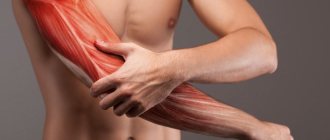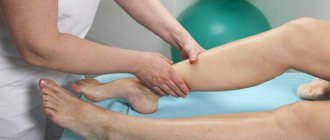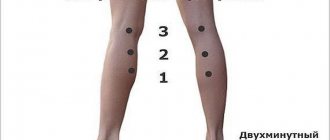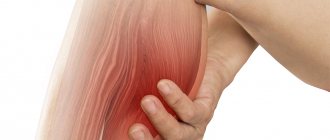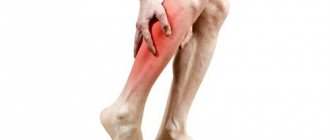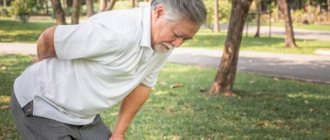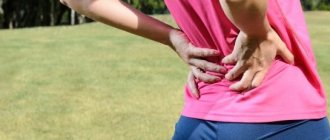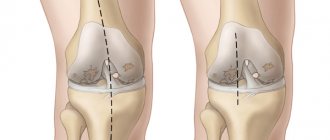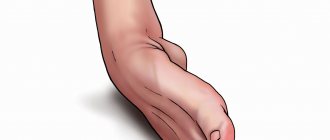Short-term painful localized (limited to one muscle or group of muscles) cramps are called cramps . They can occur in any muscle group, but are most common in the calf muscles. And it looks like this: we lie on our backs and after a slight movement of our toes, “ convulsive pain in the calf muscles ” occurs, tightening and squeezing, extremely unpleasant. Such pain can also occur when we take off our shoes. By its nature, it is a prolonged tonic contraction of the muscle, lasting from several seconds to minutes.
Most often, cramps are associated with diseases of the lumbar spine (for example, osteochondrosis), in which, sooner or later, the nutrition of the nerve endings and muscles in the legs is disrupted, so they do not receive all the necessary nutrients and begin to work “not correctly.” Such cramps occur after physical exertion or at night while lying down.
Separately, stenosolia is distinguished - this is compressive pain in the soleus muscle (it is located deeper under the calf), also very unpleasant pain, but a little weaker than cramps. This muscle has a special structure and is very sensitive to disturbances in microcirculation in it. Stenosolia most often occurs when we lie on our side or stand for a long time, walk, or sit.
Mechanism of development of gastrocnemius muscle cramp
To understand the mechanism of development of calf muscle cramps, it is necessary to understand some of the features of its structure. So, this muscle is represented by many myofibrils. Each myofibril is a strip with hundreds of rows of muscle cells. They are called myocytes.
Each muscle cell (myocyte) has a contractile apparatus consisting of several proteins. The main one in them is actin, and the auxiliary ones are troponin, myosin and tropomyosin. Myosin and actin are intertwined with each other like filaments. Their mutual approach, and therefore muscle contraction, occurs under the influence of ATP, calcium ions, troponin and tropomyosin.
This is a multi-level process that goes through several stages:
- An impulse arises in the brain, which is sent along the nerve to the calf muscle.
- With the help of acetylcholine, the electrical impulse from the nerve passes to the surface of the muscle.
- This impulse then spreads throughout the muscle fiber and penetrates its deep structures through T-shaped channels.
- From the channels, the impulse passes to the cisterns (cells containing calcium ions). Calcium channels open and calcium leaves the cells.
- Calcium activates tropin and tropomyosin, which in turn cause actin and myosin filaments to move closer together. ATP takes part in this process.
- Muscle contraction occurs at the moment when the myosin and actin filaments come as close as possible.
If a failure occurs at any stage of this complex process, it will lead to seizures.
Video: neuropathologist on the causes and treatment of seizures during sleep:
What to do during a cramp
- Pull the toe of the leg on which the cramp has developed slightly towards you, then loosen the traction, then pull as much as possible. If the muscle spasm does not go away after this procedure, you need to stand on your leg and walk a little - these simple actions will speed up the blood flow in the limb and the cramp will most likely pass.
- Apply a light massage to the area of spontaneous muscle contraction from the periphery to the center.
- Massage your leg with warming ointment and knead it.
- Pinch the spasmed muscle or prick it with a needle.
- After the cramp has passed, you should lie down for a while with your legs elevated - in this position, the outflow of blood from the lower extremities will improve, which means that the likelihood of a repeat cramp will decrease.
Causes of calf muscle cramps
There are five main factors that can lead to the development of calf muscle cramps.
Among them:
- Disturbances in the functioning of the brain.
- Excessive amount of acetylcholine in the synaptic cleft.
- Low ATP levels.
- Insufficient excitability of myocytes.
- Defects in contractile proteins that occur at the genetic level.
It would seem that all these terms are difficult for the average person to understand, but in fact they hide pathologies and disorders familiar to everyone. You just need to look at them in more detail.
Brain disorders
The cerebellum is responsible for maintaining the tone of the calf muscle. Even when a person is sleeping, this part of the brain continues to send impulses to it and other muscles, but not with the same intensity as during wakefulness.
Diseases that can lead to an increase in impulses sent by the cerebellum:
- Epilepsy.
- Psychosis in the acute phase.
- Eclampsia.
- Received traumatic brain injury.
- Hemorrhage into the cranial cavity.
- Thromboembolism of the brain.
Eclampsia develops only in pregnant women. This condition is dangerous for her life and the life of the child. Eclampsia does not occur quickly and with lightning speed, it makes itself felt gradually. First, the pregnant woman’s blood pressure rises, swelling forms in her legs, and her overall health begins to deteriorate. During the same period, she may develop cramps in the calf muscles. In the future, they will affect the uterus and can lead to placental abruption and serious health complications. Therefore, convulsions in pregnant women can be a rather ominous signal.
Excessive amounts of acetylcholine in the synaptic cleft
Acetylcholine takes part in the process of transmitting impulses from nerves to muscle cells. If there is too much of it in the synaptic cleft, it will cause the muscles to contract convulsively.
Reasons for increasing acetylcholine:
- Lack of magnesium in the body.
Magnesium is an essential electrolyte that is responsible for many functions in the body. Among other things, it regulates the opening of channels containing acetylcholine. If there is little magnesium, then these channels will be closed, which will provoke the development of cramps in the calf muscles.
The following reasons will lead to a lack of magnesium in the body:
- Adherence to diets, poor nutrition.
- Malabsorption syndrome, intestinal inflammation, intestinal resection. All these conditions lead to the fact that magnesium will be poorly absorbed in the body.
- Excessive intake of calcium from food, as well as consumption of fatty or protein foods, impedes the absorption of magnesium in the intestines.
- Sometimes conditions arise in which the body spends more magnesium than it receives. This occurs during times of stress, during intense sports training, during pregnancy and lactation, during periods of active growth of the body, during the recovery of the body after illnesses. Each of these conditions will contribute to the development of calf muscle cramps.
- Sometimes magnesium is excreted from the body in large quantities, for example, through vomiting, diarrhea, or taking laxatives. A lack of magnesium is observed in coffee and strong tea drinkers and alcoholics. In this regard, kidney disease, diabetes mellitus, taking sorbent drugs, and undergoing therapy for cancer pathologies are dangerous.
- Magnesium deficiency and leg cramps can often bother people with endocrine pathologies, such as hyperthyroidism, hyperparathyroidism, hyperaldosteronism.
- Overdose of drugs.
In this regard, it is dangerous to take drugs that block an enzyme called cholinesterase, which, in turn, destroys acetylcholine. If there is little cholinesterase, then acetylcholine will accumulate in the synaptic cleft and cause muscle contractions in the form of cramps. Such drugs include Axamon, Alzepil, Ipigrix, Nivalin, Exelon, etc.
As practice shows, it is the lack of magnesium that is the most common cause of calf muscle cramps in people of all ages. In addition to convulsive muscle contractions, they will be bothered by hearing impairment, migraine-type headaches, skin diseases and alopecia, back and abdominal pain, and bowel disorders.
In childhood, a lack of magnesium leads to heart disease, vascular spasms, deterioration of the immune system and other serious problems.
If this condition is not treated, then in addition to cramps in the calf muscles, the person will experience cramps in the hands, back, neck muscles, and facial muscles.
Insufficient excitability of myocytes
If the excitability of the muscle cells representing the calf muscle is insufficient, then the person will develop a cramp. Such disorders can be caused by an imbalance of electrolytes in the body and a deficiency of vitamins.
The main electrolytes of the human body are: sodium, potassium, calcium and magnesium. Various conditions can lead to imbalance: increased physical activity, oxygen starvation and physical inactivity, lack of water in the body due to various diseases or when eating too salty food without the opportunity to get drunk.
Excessive intake of water into the body is no less dangerous. This can also lead to fluid and electrolyte imbalance and the development of seizures.
Vitamin deficiency affects muscle contractility. Cramps in the calf muscles can occur in people who do not receive enough vitamin D, E, A, and B. Most often, the cause of such deficiency is dietary errors.
Low ATP level
The following diseases and conditions can lead to a decrease in the concentration of ATP, as the main carrier of energy in the human body, and therefore to the development of cramps in the calf muscles:
- Anemia, regardless of its origin, heart failure, vascular disease, lung disease, influenza, adenoiditis, altitude sickness. All these conditions have in common that they cause hypoxia of muscle tissue, which means they can cause seizures.
- Low blood sugar with developing hypoglycemia, as well as diabetes.
- Lack of B vitamins in the body (B1, B2, B5, B6).
- Magnesium deficiency.
- Taking diuretics.
- Hypothyroidism.
- Treatment with statins.
- Inferior vena cava syndrome.
- Varicose veins.
- Thrombophlebitis.
- Atherosclerotic vascular lesions.
- Hard physical labor.
- The rehabilitation period after surgery.
- Following a low-calorie diet.
You need to be prepared for the fact that the calf muscle will sooner or later cramp if a person works out in the gym. Therefore, during intense training, it will not be possible to do without taking vitamin and mineral complexes.
Genetic diseases
The calf muscles can cramp in people who suffer from genetic pathologies. These diseases remain incurable today, but they are not common. An example of such a pathology is Tourette's disease. In addition to seizures, a person experiences tics and involuntary screams.
Other causes of leg cramps
If a person is injured or has a broken bone, then muscle cramps act in this case as a protective mechanism. It is aimed at limiting the mobility of the injured area. On the other hand, it is muscle spasm, as a reaction to pain, that is the main cause of fracture of tubular bones when a person falls from a height.
The cause of cramps in the calf muscles can be osteochondrosis, a herniated disc, a perineural cyst, or a tumor that compresses the S1 and S2 vertebrae. After all, it is at the level of the sacral spine that the roots of the nerve plexuses are located, which go to the calf muscles.
Another cause of calf muscle cramps is transverse flatfoot and other foot abnormalities, which lead to a redistribution of the load on the calf muscle ligaments. It also affects the deterioration of blood flow, compression of nerve trunks and overstrain of joints.
Local clonic seizures
The reasons for periodic twitching of a particular muscle may be the most unexpected. For example, strong emotional experiences, stress, due to which excitation in our body begins to prevail over inhibition, various neuroses arise.
Or heredity, due to which we inherited easily excitable muscles. If your grandmother or mother often complained of local convulsions, this is from them. An unhealthy diet lacking essential micronutrients (crash diet) can also cause these symptoms. On the one hand, they do not cause serious concern, but they are not easy to get rid of.
What to do? The problem of muscle fasciculations becomes significant for the doctor and the patient when twitching occurs too often and really interferes with life. In this case, you should contact a neurologist. The course of treatment may take some time and include taking vitamins and minerals, medications that affect the nervous system (including sleeping pills and antidepressants), physiotherapy and massage.
Calf muscle cramps in pregnant women
If we exclude developing eclampsia, which was described above, then cramps in the calf muscles in pregnant women may develop due to early toxicosis. During vomiting, which is its companion, the body loses many vitamins and microelements, which is sure to affect the condition of the muscles. In addition, useful substances are spent on the needs of the growing fetus.
The situation is aggravated by hormonal changes and stress that the body experiences. All this contributes to an increase in cramps in the calf muscles. To cope with them, you need to pay enough attention to proper nutrition. It is imperative to follow medical recommendations and take vitamin and mineral complexes.
Another common reason that leads to the development of seizures is varicose veins in pregnant women. Most often, the disease begins to develop before conception, and as the fetus grows, its course only worsens. In addition to leg cramps, the woman will experience heaviness in them. She may be bothered by swelling, which develops both in the evening and in the morning.
Another cause of calf muscle cramps during pregnancy is the syndrome of the inferior vena cava, which is compressed by the uterus. Venous outflow decreases, which provokes a cramp in the leg. During multiple pregnancies, this problem occurs in almost every woman.
To minimize the likelihood of cramps in the calf muscles, a woman should sleep on her side. It is not recommended to spend a lot of time on your feet; you should definitely give them rest. It is useful to perform gymnastics for pregnant women to strengthen muscles and prevent their oxygen starvation.
Prevention measures
The prevention program includes:
- adherence to daily routine;
- eating greens, especially parsley, fruits, whole grains and dairy products;
- running, swimming;
- leg muscle massage;
- selection of comfortable shoes.
You can train your calf muscles by tensing and relaxing them during exercise and running. In your diet, you should pay attention to salt consumption. Excess and lack of salt leads to health problems.
When your legs cramp at night, it is impossible to sleep. If the attack is fleeting, then it’s not so bad. You can remove it yourself. But sometimes long-lasting painful spasms can be a symptom of a serious illness. And then all that remains is to seek medical help.
Calf muscle cramps in healthy people
Sometimes cramps in the calf muscles can develop in absolutely healthy people, that is, contractions will not be caused by any pathological diseases, but by external causes.
These include:
- Excessive stress on the legs. Moreover, a cramp can develop not only under dynamic, but also under static loads. This is often associated with a person’s professional activity. Thus, leg cramps often bother ballerinas, circus performers, professional athletes, loaders, salesmen, teachers, hairdressers, and surgeons.
- Sleeping in an awkward position. The fact is that at night, between 2.00-4.00 hours, the maximum concentration of free calcium in the muscles is observed. At the same time, blood glucose (ATP) levels drop. If during this period a person sleeps in an uncomfortable position, squeezing the veins of the legs, this will certainly provoke a cramp in the calf muscle. The situation is aggravated by insufficient oxygen concentration in the room, that is, sleeping in stuffy rooms.
- Cramps in the calf muscles can result from exposure to toxic substances in the human body, for example, from insect bites or pricks from sea urchin needles.
- A person can experience a cramp in their leg if they spend a long time in the cold. This is especially true when there is a sharp temperature change.
- Women who like to wear high heels and tight dress shoes will suffer from calf cramps more often than women who wear comfortable orthopedic shoes.
- Tight and narrow clothing, as well as things with tight belts and elastic bands, can lead to disruption of blood flow in the lower extremities and cause cramps in them.
How to treat
Regular paroxysms of the calf muscles can be stopped using pharmaceutical drugs. Traditional healers advise fighting seizures with their proven methods.
Drug treatment
There are a number of medications available to relieve muscle spasms. Their action is aimed at eliminating convulsive symptoms and pain. Tablets of Levetiracetam, Pregabalin, Trental are used after a doctor’s prescription for neurotic conditions.
If paroxysms are associated with a lack of microelements and vitamins, then Asparkam and Panangin are prescribed. To combat vascular disorders, which cause pain in tense muscles at night, you need to take the drugs Troxevasin and Venarus.
Ointments based on horse chestnut stimulate blood circulation and metabolic processes in the affected area. They are applied to the calves before bed, gently rubbing into the skin. It is known what to do if there is a deficiency of vitamins in organisms. The Dolgit and Complivit complexes will restore the conductivity of nerve impulses and prevent muscle spasms.
Physical methods
Among the main methods of relieving muscle tension at night is the effect of magnetic waves on the affected area. The magnetic therapy device normalizes the blood supply to tissues. The cells will receive sufficient nutrition and oxygen, and the convulsions will stop.
Relaxation of muscle tissue occurs under the influence of electric current and ultrasound. Used in cases where the leg is cramped, massage. Done regularly, it will relieve night pain. It is advisable to undergo a course of manual therapy to relieve the effects of frequent leg strain. The calf muscles will recover due to the normalization of blood flow in them.
A professional massage therapist will quickly relieve a seizure attack.
Folk remedies
Treatment with herbal preparations will have a beneficial effect on the condition of the limbs and will not cause side effects:
- Medicinal wormwood 30 grams is poured with boiling water into 400 ml. After infusion and straining, drink a quarter glass 3 times a day. For rubbing, you can use tincture of wormwood in alcohol.
- Take 1 teaspoon of chopped dill fruits, pour 300 ml of hot boiled water. Leave for an hour. Take half a glass or 1 gram of dry fruit powder three times.
- For smooth muscle spasms, mint tablets under the tongue help.
- Tincture of black henbane leaves is useful as an antispasmodic and analgesic. The medicine is prepared from 15 grams of raw materials and 100 ml of vodka. It is better to take 2 drops, diluting them in a tablespoon of water.
- Celandine juice is added to Vaseline and lubricated with the resulting caviar ointment in the evening.
- A pinch of salt is placed on the tongue and held for several minutes. The pain goes away instantly.
- Chamomile flower tea is beneficial for those who suffer from nighttime calf muscle cramps.
Any remedy based on medicinal plants is taken after consultation with a doctor. After all, they may have contraindications.
First aid for calf cramps
If leg cramps are not associated with an epileptic attack, then you need to perform the following simple measures:
- The leg must be elevated to improve blood flow and eliminate existing stagnation.
- You need to grab the toes of the lower limb and bend them towards the knee. First, they are bent halfway and relaxed, and then bent as far as possible and held in this position. This will stop the seizure.
Following these recommendations allows you to stretch the calf muscle, due to which it, like a sponge, absorbs blood saturated with oxygen. Foot massage can improve blood circulation through small blood vessels. Movements should be light and smooth. They come down to pinching and stroking the limb.
Injecting soft tissues with a pencil or other sharp object (without damaging the skin) allows you to interrupt the reflex chain and stop the spasm. This technique is actively used by professional swimmers, who always carry a pin with them. In this way they get rid of the cramp that happened at depth.
After the attack of cramp has been stopped, it is necessary to give an intensive massage to the muscle and stretch it.
To minimize the likelihood of cramping during exercise, your muscles should be warmed up and stretched before you begin. To do this, perform bends with lunges, body bends without lunges, and squats. While bending, exhale and only after that you need to stretch the muscles.
Video: 3 ways to relieve cramps:
What to do if your calf muscle cramps in water?
If a cramp catches a person while swimming in a pond, then under no circumstances should you give in to panic. Whenever there is such an opportunity, you need to loudly call for help. In this case, you must continue to swim towards the shore, actively working with your hands.
The simplest solution is to roll over onto your back. At the same time, you need to breathe deeply and continue to swim towards the shallows using your hands.
If a person is confident in his abilities, then he can relax in the water, taking the form of a starfish. While floating on the water, you need to massage the calf muscle until the cramp goes away. You need to be prepared that in such a position a person will have to plunge headlong into the water from time to time. Therefore, this method can only be put into practice by a swimmer who feels confident at depth and knows how to hold his breath.
So, immediately after a cramp occurs, it is necessary to direct all efforts to eliminate it. After all, this condition is stressful for the body and needs to be eliminated as quickly as possible. Only after this should you search for and treat the cause of calf muscle cramps.
Precursors of spasm and first aid
During sleep, they wake up from a cramp in their leg. When you lie down tired and your legs are heavy, then, most likely, a cramp attack will begin at night. Its onset is associated with increasing pain in the center of the calf. By nature it is burning, bursting. Swelling of the veins and swelling below the affected area are noted.
The arteries are compressed by a tense muscle, and the pulsation in them is not visible. You can notice changes in the calves by the pale skin and bluish tint. At the end of the attack, when the capillaries dilate, the leg becomes red.
Is it possible to run in the evening before bed?
You can help yourself by doing the following:
- Pull your foot towards you to stretch the cramped muscle.
- By gently massaging the calf, you can stop the spasm.
- The contracted limb rises upward, above the head.
- Pricking the calf several times with a pin will relieve the pain.
- Apply a cloth moistened with hot water to the affected area. You can add 1-2 drops of lavender or ginger oil to the water.
- Take your leg back, pressing the sole to the floor, the ground. For convenience, you need to rest your hands on the wall.
- Walk around the room, then take a warm bath.
Usually one of the actions stops the convulsive contraction. If there is no result, it is better to call an ambulance.
